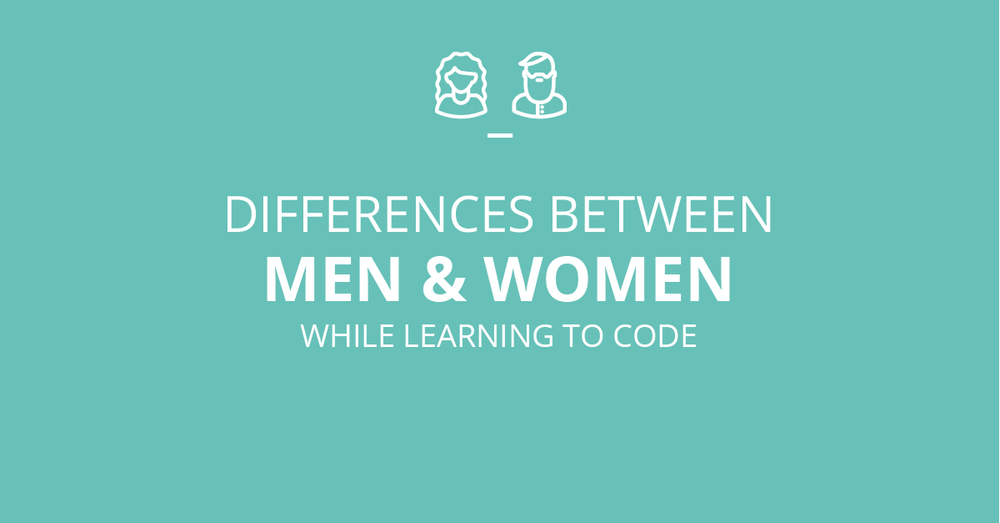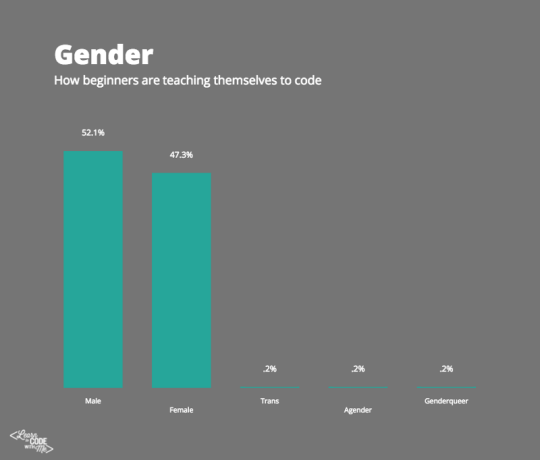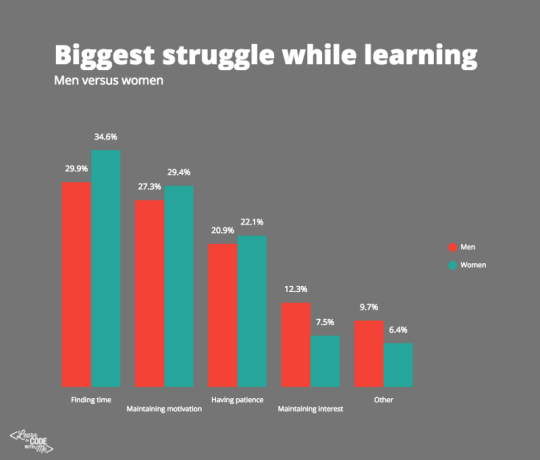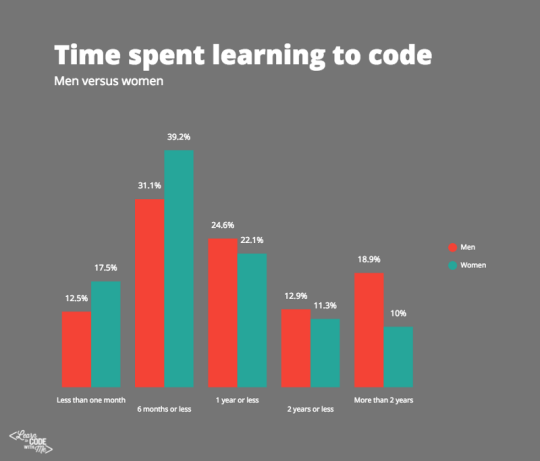Differences between male and female self-taught coders.
By Laurence Bradford (Founder, Learn to Code With Me)
This post originally appeared on Medium.
Technology jobs are primarily the domain of men.
Although there has been a push to promote women in tech over the last few years, there still seems to be a divide, with men outnumbering women at all of the major tech companies — usually hovering at or below a 70/30 split.
Does this mean women simply aren’t interested in learning tech skills, like programming?
As the creator of a website that helps people teach themselves coding skills — and a woman — I decided to dig a little deeper into my readership.
In a recent survey I conducted on Learn to Code With Me, I was happy to see a relatively even balance between the genders. Specifically, 264 people who identify as men took the survey, compared with 240 people who identify as female.
Of course, there are biases in the data. The survey was not scientific. As all answers were self-submitted, they are, from a technical standpoint, unverifiable.
Below are 9 things I discovered from the survey.
 Insight #1: Men Learning to Code are Younger
Insight #1: Men Learning to Code are Younger
Slightly more men fell into the under 18 and 18–24 age groups.
More women were between 25–34 years old, though the 25–34 group is the largest one for both genders.
Men essentially outnumbered women in every age group, except 25–34 years old. About half of the women who took the survey were between 25–34 years old. Coincidentally, or maybe not, that’s the age group I am in.
Insight #2: Women Spend Less Time Learning Every Week Compared to Men
Overall, women surveyed spent less time learning to code every week than their male counterparts. In fact, almost half of the women who took the survey said they spent five hours or less learning every week. 115 women said they spent 0–5 hours learning every week, whereas only 90 men said they spent 0–5 hours learning.
When looking at the people who said they spend over 20 hours every week learning:
- 30 were men
- 16 were women
Insight #3: The Women Learning 20+ Hours a Week are More Educated (and Older)
Who were these small minority of women (16) that were spending over 20 hours a week learning?
These 16 women:
- were mostly between ages of 25–34 (10), followed by 35–44 (4)
- were highly educated: 8 had a post-graduate degree, 5 were college graduates
- 15 of these women cited “Better career” as a reason why they were learning
- 7 said they were currently “out of work and looking for work”
The 30 men, on the other hand, who were learning for 20 hours or more every week:
- were mostly between the ages 18–24 (10) and 25–34 (10)
- were not as educated* as the women: college graduate (12), followed by some college (5), and then high school graduate (4)
- 18 of these men cited “better career” as the reason why they were learning. 18 of them also said to “create a business/startup”
- 9 said they were “out of work and looking for work”, 8 said they were “employed (full-time)”
*Less educated could also be due to the fact that many of these men are younger.
 Insight #4: When it Comes to Struggles, There’s Not Much of a Difference
Insight #4: When it Comes to Struggles, There’s Not Much of a Difference
“Finding time” and “maintaining motivation” were the top answers for both genders, though they were chosen by a slight majority of women.
Men were more likely to cite “maintaining interest” as a struggle (12.5% to their female counterparts’ 7.5%).
Insight #5: A lot of Women are From the US
Under half (44.3%) of male respondents hailed from the United States, but nearly two-thirds (62.5%) of women did so.
This is likely not representative of the worldwide statistics for women in tech careers, however. Case in point: this article by Forbes reports that other countries are outpacing the U.S. in tech careers/education.
Insight #6: Men and Women Equally Want to Pursue Web Development. Women want to do Web Design at Higher Rates, Men Want to be Software Engineers.
Almost half of both genders chose web development as their ideal career. The other choices were more markedly split, with women favoring UX/UI and design, and men gravitating toward software engineering and mobile development.
 Insight #7: Women Have Been Teaching Themselves for a Shorter Period of Time Compared to Men
Insight #7: Women Have Been Teaching Themselves for a Shorter Period of Time Compared to Men
A total of 56.7% of the women surveyed by LTCWM had been learning for six months or less, compared to 43.6% of surveyed men. Moreover, 18.9% of the men had been learning for over two years, contrasted with 10% of the women.
That said, Quincy Larson told me that on Free Code Camp, women tend to stay for longer sessions than the men.
This could mean that even though women have been learning for less time in the macro sense, they are learning more in the day-to-day.
Or that women are more engaged overall.
I have also found that women tend to stay on my site longer than men.
Insight #8: Men Want to Start Businesses, Women Want to Freelance
A majority of both genders chose “full-time employment” as their ideal scenario. For women, that was followed up by freelancing (38.8%), then founding a small business/startup (14.2%).
Men were more evenly split between those two options, with 29.5% choosing small business ownership and 28.8% choosing freelancing.
Nonetheless, when looking at the graph above, you can’t help but notice the huge difference between men and women that want to create businesses or startups.
Insight #9: Men use Windows More, Women Use Mac More
Over 60% of men surveyed used Windows as their preferred OS; only 27.3% chose Mac. Women, meanwhile, were almost equal: 47.5% used Windows and 48.8% chose Mac. The increased popularity of Mac with the female respondents could be correlated with the women’s greater interest in design-related careers. (It’s pretty commonly accepted that Macs are better for doing design work.)
Conclusion
Considering the hundreds of thousands of people learning to code, ~500 is a relatively small sampling — so make of this what you will.
It’s also worth noting that Alexa (a web analytics company) features the demographics of major learn to code sites, including Udacity, Code School, Codecademy, and Treehouse, and shows that women were underrepresented there.
My larger-than-average female audience may be attributable to the fact that I am female myself, and thus have increased exposure among female coders — and thus have a higher “relatability” factor. Or it may be something else entirely. Either way, I’m pleased to see that the information I publish appeals more equally across genders.
Whether or not these data are evidence of a larger trend, there’s one thing they illustrate for sure: men and women are teaching themselves how to code.
Note: all data in this article has been derived from a recent Learn to Code With Me survey. Download the full report here, which includes all of the raw data. #GeekOut
About the guest blogger: Laurence Bradford creates resources for self-taught coders on her website Learn to Code With Me. She’s also the Tech Careers Expert at About.com where she writes about tech job trends. Follow her on Twitter at @learncodewithme.

 Insight #1: Men Learning to Code are Younger
Insight #1: Men Learning to Code are Younger Insight #4: When it Comes to Struggles, There’s Not Much of a Difference
Insight #4: When it Comes to Struggles, There’s Not Much of a Difference Insight #7: Women Have Been Teaching Themselves for a Shorter Period of Time Compared to Men
Insight #7: Women Have Been Teaching Themselves for a Shorter Period of Time Compared to Men